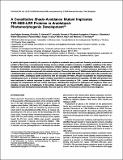Por favor, use este identificador para citar o enlazar a este item:
http://hdl.handle.net/10261/28831COMPARTIR / EXPORTAR:
 SHARE SHARE
 CORE
BASE CORE
BASE
|
|
| Visualizar otros formatos: MARC | Dublin Core | RDF | ORE | MODS | METS | DIDL | DATACITE | |

| Título: | A constitutive shade-avoidance mutant implicates TIR-NBS-LRR proteins in Arabidopsis photomorphogenic development |
Autor: | Faigón Soverna, Ana; Harmon, Franklin G.; Storani, Leonardo; Karayekov, Elizabeth; Staneloni, Roberto J.; Gassmann, Walter; Más, Paloma CSIC ORCID; Casal, Jorge J.; Kay, Steve A.; Yanovsky, Marcelo J. | Fecha de publicación: | 17-nov-2006 | Editor: | American Society of Plant Physiologists | Citación: | Plant Cell 18(11): 2919-2928 (2006) | Resumen: | In plants, light signals caused by the presence of neighbors accelerate stem growth and flowering and induce a more erect position of the leaves, a developmental strategy known as shade-avoidance syndrome. In addition, mutations in the photoreceptors that mediate shade-avoidance responses enhance disease susceptibility in Arabidopsis thaliana. Here, we describe the Arabidopsis constitutive shade-avoidance1 (csa1) mutant, which shows a shade-avoidance phenotype in the absence of shade and enhanced growth of a bacterial pathogen. The csa1 mutant has a T-DNA inserted within the second exon of a Toll/Interleukin1 receptor-nucleotide binding site-leucine-rich repeat (TIR-NBS-LRR) gene, which leads to the production of a truncated mRNA. Arabidopsis plants transformed with the truncated TIR-NBS-LRR gene recapitulate the mutant phenotype, indicating that csa1 is a dominant-negative mutation that interferes with phytochrome signaling. TIR-NBS-LRR proteins have been implicated in defense responses in plants. RPS4, the closest homolog of CSA1, confers resistance to Pseudomonas syringae and complements the csa1 mutant phenotype, indicating that responses to pathogens and neighbors share core-signaling components in Arabidopsis. In Drosophila melanogaster and Caenorhabditis elegans, TIR domain proteins are implicated in both development and immunity. Thus, the dual role of the TIR domain is conserved across kingdoms. | Descripción: | 11 pages, 10 figures.-- PMID: 17114357 [PubMed].-- PMCID: PMC1693933.-- Supplementary information available at: http://www.plantcell.org/cgi/content/full/tpc.105.038810/DC1 | Versión del editor: | http://dx.doi.org/10.1105/tpc.105.038810 | URI: | http://hdl.handle.net/10261/28831 | DOI: | 10.1105/tpc.105.038810 | ISSN: | 1040-4651 | E-ISSN: | 1532-298X |
| Aparece en las colecciones: | (IQAC) Artículos |
Ficheros en este ítem:
| Fichero | Descripción | Tamaño | Formato | |
|---|---|---|---|---|
| Faigon_Soverna_et_al.pdf | 772,33 kB | Adobe PDF |  Visualizar/Abrir |
CORE Recommender
PubMed Central
Citations
31
checked on 27-mar-2024
SCOPUSTM
Citations
82
checked on 24-abr-2024
WEB OF SCIENCETM
Citations
80
checked on 23-feb-2024
Page view(s)
349
checked on 24-abr-2024
Download(s)
357
checked on 24-abr-2024
Google ScholarTM
Check
Altmetric
Altmetric
Artículos relacionados:
NOTA: Los ítems de Digital.CSIC están protegidos por copyright, con todos los derechos reservados, a menos que se indique lo contrario.
